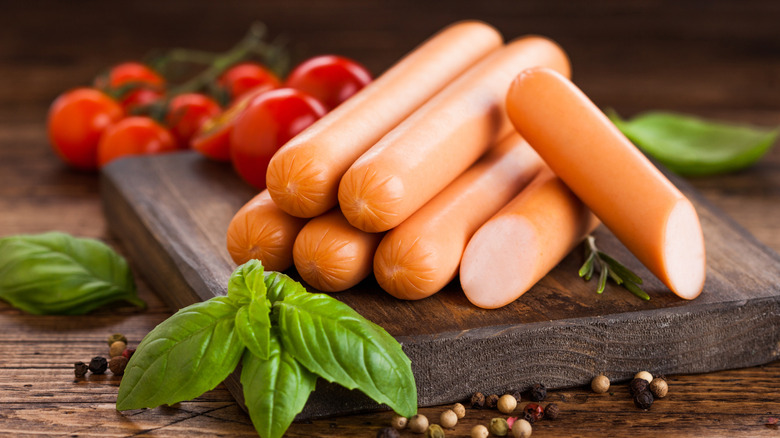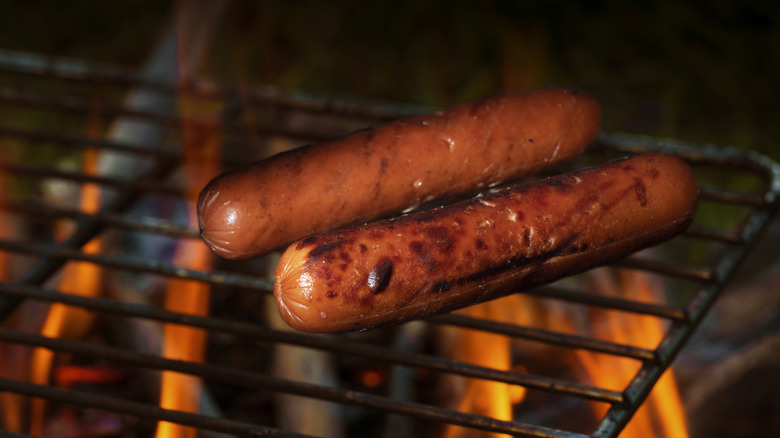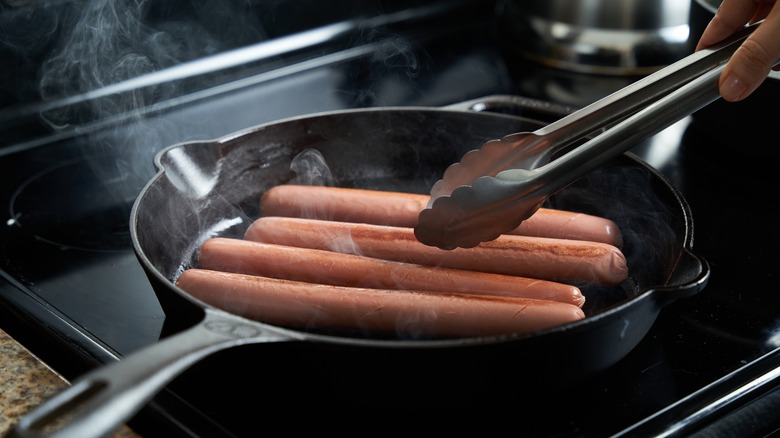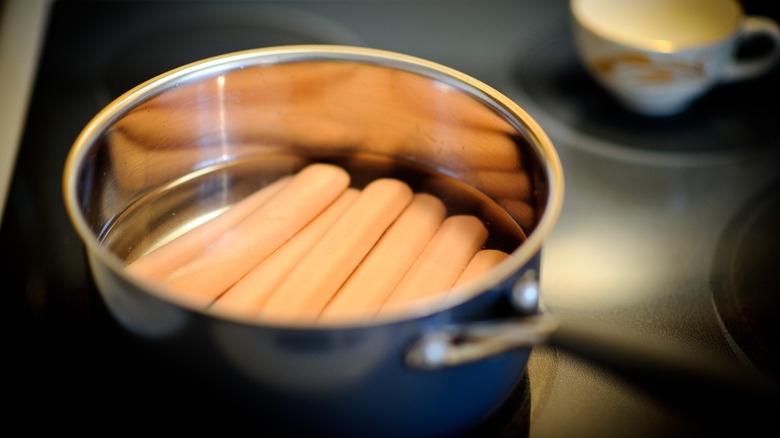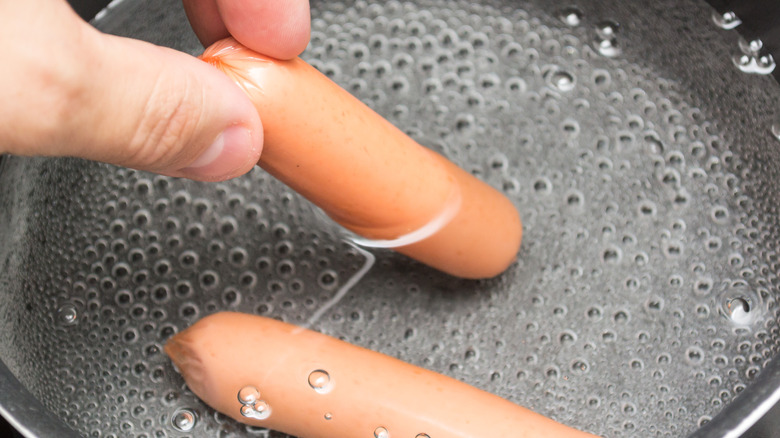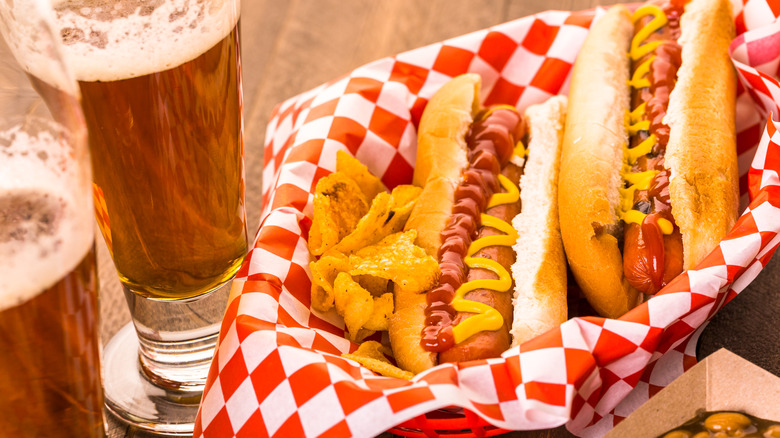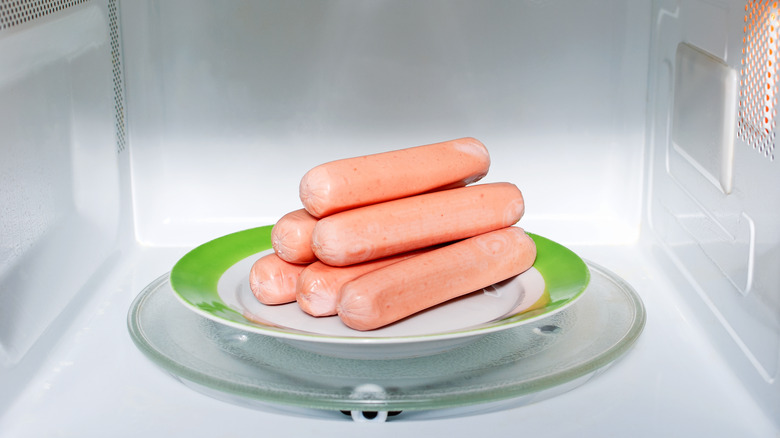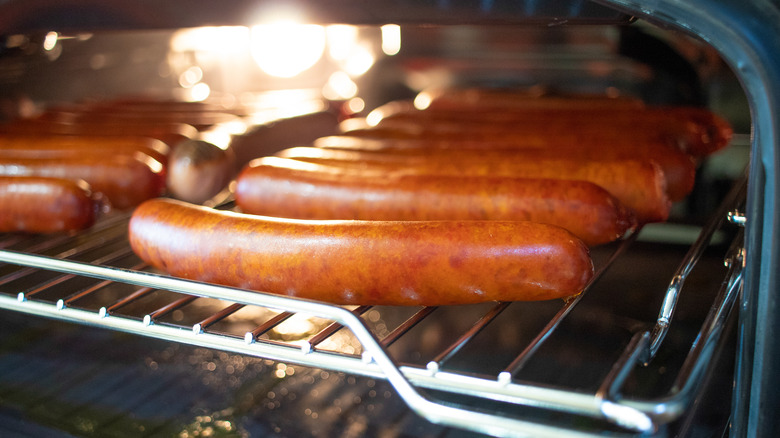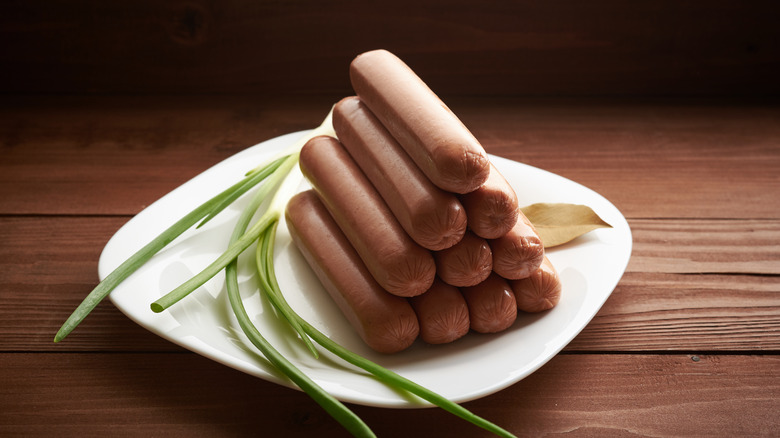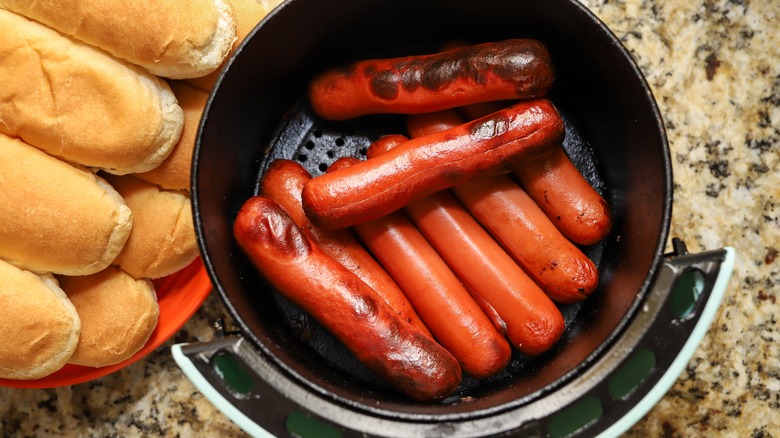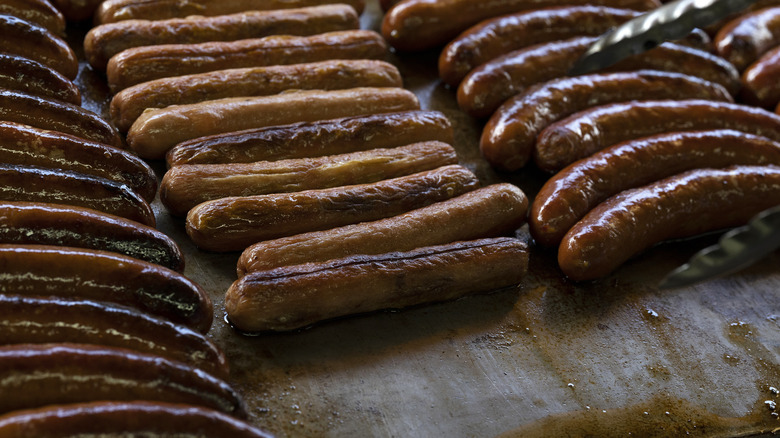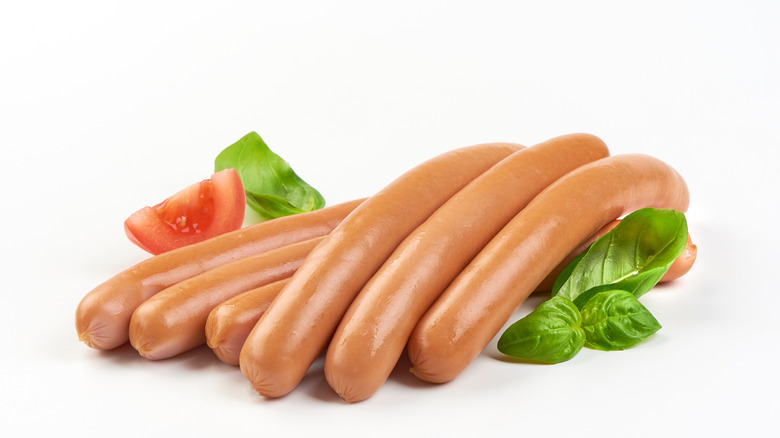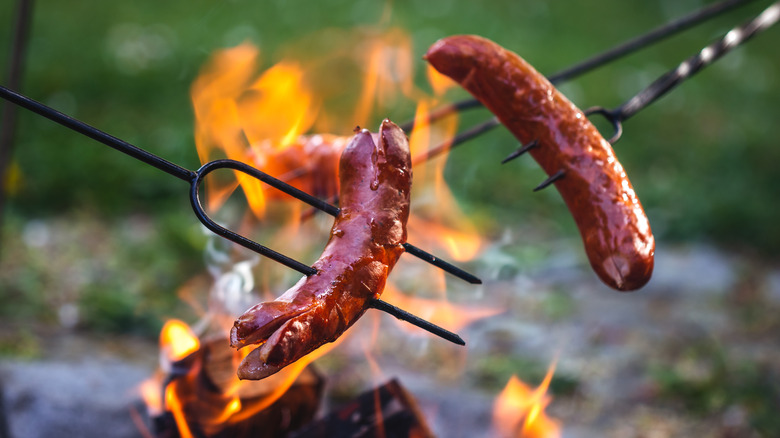12 Different Ways To Cook Hot Dogs
Hot dogs are a popular food in the United States, primarily due to easy preparation methods and their association with sporting events and barbecues. Although some reject them because they contain food additives and meat trimmings, hot dogs are an excellent way to decrease food waste and use most animal parts. German immigrants popularized hot dogs (Germany has a long culinary tradition of making sausages), but they slowly became an American staple food as cooking methods diversified and people became more creative with toppings and sauces.
You can enjoy hot dogs in many parts of the U.S., each with own its style, buns, and topping combination. First, check out this roundup of the best hot dogs in America and give them a try if you're in the area of them. On the other hand, you might want to make your hot dog at home, so you might be curious about the best grocery store hot dogs you can find. Lastly, maybe you're out of ideas about cooking hot dogs. In that case, take a look below and see all the possible methods you can use before picking your favorite.
Throw hot dogs on the grill
There's no summer BBQ without a generous helping of hot dogs to bite into and top with the most delicious and imaginative sauces. In fact, hot dogs are so popular for summer grills that many people consider these gatherings incomplete if there are no hot dogs on the menu. And according to Western AG Network, the vast majority of Americans (75%) prefer grilled hot dogs instead of any other cooking method. The reason for this preference is probably the excellent smoky flavor characteristic of grilled meat, the crunchy exterior, and the fact that the sausages are less likely to break from the heat. So, what makes the perfect grilled hot dog?
The golden rule of hot dog grilling appears to be coating the franks in oil so they don't stick to the grill. Chef Daniel Boulud makes perfect beef franks using this method and then searing the outside of the hot dog. In the chef's recipe, the smoky flavor from the grill is enhanced by the use of rosemary and thyme. When you grill hot dogs, it's also essential to clean the grill so that there is nothing to stick to the hot dogs. Next, place the hot dogs in an area that is not directly over the flames and keep rolling them until the ends start to split. After you remove the franks from the grill, use them in your favorite recipe. And, if you don't have one, we've got the ultimate hot dog recipe.
Pan-fry hot dogs for a perfect crust
Who said that hot dogs could only be summer food? You can find yourself craving that delicious taste and crunchy texture during any season or when the weather conditions are not ideal for grilling. Luckily, you can have hot dogs that taste fresh from the grill without the fuss of outside cooking. The solution is to pan-fry hot dogs to get that same brown and crispy outside and juicy inside.
There are several things you can do when you pan-fry hot dogs. First, you can make diagonal cuts so that the franks don't become too puffy, and you don't risk breaking their casing while cooking. As the hot dogs will lose some of the interior moisture, cutting them is optional, depending on how you like them. Then, you can brown them in the heated skillet or use butter (maybe mixed with oil). Browning them in the skillet with no added fat will result in hot dogs resembling the grill flavor. Browning them in butter will give them a better-looking color but a different taste and texture, as they will become dryer.
Another way to pan-fry hot dogs is to use hot dog leftovers in different recipes, mixing them with other ingredients. For instance, you can try cutting them and tossing them into the pan with some eggs for an excellent breakfast dish.
Boil hot dogs for the ultimate plump
Although grilling hot dogs gives them that great characteristic flavor, boiling them has advantages. Granted, it will render a mellower taste and a lighter color, but good hot dogs will become crunchier when boiled. Also, boiling hot dogs is an excellent way of feeding a crowd because you will be able to have more hot dogs ready in no time, especially compared to grilling, which requires your full attention for fewer franks that are cooking at the same time. So, before you choose your hot dog cooking method, think about each particular situation and what you need.
You will need four to six minutes to boil hot dogs if they are refrigerated. The hot dogs should be covered in water and gently placed in the cooking dish, not dropped in after the boiling begins. That's the surest way to split their skins. The franks will plump up and become crunchy when covered in cold water and heated progressively. Hot dogs are done when their internal temperature reaches 140 degrees Fahrenheit (via USA Today). A more straightforward way to know if they are done is to check their texture, as cooked hot dogs have wrinkly skin and a darker color. Avoid leaving hot dogs in hot water because this will cause them to get mushy. To keep them warm, use a crock pot, wrap them in aluminum foil, or keep them in a large thermos.
Enjoy crunchy hot dogs simmered in water
Although boiling hot dogs is a method used frequently, it's not recommended by famous producers of hot dogs like Nathan's. Instead, they recommend a more subtle cooking method to preserve the flavor and make the hot dogs crunchy: simmering them. Simmering hot dogs is also recommended by meat master salumist Elias Cairo of Olympia Provisions (via Today). So actually, it makes perfect sense to say that boiling hot dogs will cause them to lose their flavor instead of simmering them for a short time in a smaller amount of water.
You can choose to simmer the hot dogs in a skillet and then brown them, still using only the skillet, or to simmer the hot dogs and grill them. Grilling boiled hot dogs is not a good idea, as these will lose all the flavor and become rubbery. For simmering in water, use enough water to cover the skillet's surface, then heat the pan until the water starts to boil. When you simmer hot dogs, you won't be able to cook in large batches as you can when boiling, but on the upside, you will get a better flavor and texture. Also, when simmering hot dogs, you will want to roll them as you do with grilling so that they come out brown on all sides.
For the ultimate flavor burst, simmer them in beer
If you're not a fan of charred hot dogs with sear marks and like boiled hot dogs, level up their flavor by simmering them in beer. Inspired by a twist in cooking bratwurst, boiling hot dogs in beer renders tons of flavor and a plump texture. The bratwurst and beer combination is a staple of German (and Bavarian) cooking, and simmering sausage in beer is a foolproof technique for enhancing the flavor. This method is ideal for those hot dogs in which condiments are not very strong, as beer will lend the hot dogs a specific taste. Of course, it all depends on the type of beer you're using, as some varieties have more robust flavors.
To simmer hot dogs in beer, choose your favorite beer type, empty a can into a pot and bring it to a boil. You should add the hot dogs in small batches to keep an eye on them and remove them once they are plump on all sides. Leaving hot dogs for too long in a boiling liquid will cause the skin to crack. To avoid this, prick each hot dog several times with a fork. Choose toppings that go well with beer flavor for beer-infused hot dogs, such as sauerkraut, hot onions, chili, or mustard.
Be careful when microwaving hot dogs
Using a microwave to prepare food is very convenient, as it's a much faster way of heating up or cooking than a regular oven. However, microwaving can come with certain disadvantages, especially concerning hot dogs. According to USDA, microwaving hot dogs can cause an arcing phenomenon, which means sparks erupt inside the microwave oven. The process can also occur when microwaving carrots or using a dish decorated with gold paint containing metal. Arcing occurs when the salts and additives are not well mixed; if the oven is not turned off immediately, it can damage it.
If you want to microwave hot dogs, follow the packaging instructions. WebMD recommends placing the hot dogs in a water dish and cooking them for at least 75 seconds on high (1,100 watts power) so they are safe to eat. Cooking for a shorter time or at a lower setting may cause the hot dogs to be under-microwaved and unsafe to consume. So, cooking hot dogs in your microwave oven may be a fast option, but you should always do so with care so that you don't undercook the hot dogs or damage your microwave.
Brown hot dogs by roasting them in the oven
A great way to get hot dogs halfway between grilled and boiled is to bake them in the oven. This manner of cooking also has the advantage of feeding a crowd, as an oven can bake more hot dogs simultaneously and doesn't require constant supervision, unlike the grill. In addition, after placing the hot dogs in the oven, you can leave them there and only take them out when they're done. On the other hand, when grilling hot dogs, you must be careful to turn them constantly so they won't burn.
The most common way to roast hot dogs in the oven is to preheat to 400 degrees F and place them in an ovenproof dish. Roasting should take about 15 minutes. After this time, the hot dogs should have a curled shape and brown color, which is the sign they are done. Of course, you can always try making "pigs in the blanket" instead of simply roasting the hot dogs. But first, of course, you must wrap the hot dogs in crescent roll dough and then place them in the oven. This way, you get hot dogs and some delicious bun alternatives.
Feed a crowd with slow-cooked hot dogs
If you're planning a party and don't have any ideas about what to serve, a hot dog bar might be something to consider. That means cooking many franks and laying out the ingredients to assemble the hot dogs (buns, toppings, sauces) so everyone makes their food. And it also means that you should find a way to keep hot dogs warm for longer.
How about slow-cooking hot dogs? You can cook a large quantity simultaneously and have a place to keep them warm for up to three hours, as slow cookers have the "warm" setting. In addition, you don't need to add water to the slow cooker with hot dogs, as they have enough moisture to create steam. But if you want a deeper flavor, try adding some beer. Slow-cooking hot dogs will mostly take up to two to three hours, so you should plan enough time for this. Also, if you're looking for some variety in taste and texture, try this method of slow-cooking brats, which you can add to hot dog buns and have a juicier and better-flavored hot dog. The recipe also allows you to enjoy the taste of brats cooked in beer alongside onions and with a dab of butter, which bring out the dish's sweetness.
Try healthier air fried hot dogs
Air fryers are a relatively new cooking appliance, so wondering if they're suitable for cooking hot dogs is a natural question. It turns out that air fryers are great for cooking hot dogs. As the appliance tends to render the same texture as open-flame grilling or pan searing, cooking hot dogs in this appliance will produce similar results. So, if you like your hot dogs crispy on the outside, nicely browned, and juicy on the inside, cook them using an air fryer.
According to Air Fryer Eats, there are two things to consider when air frying hot dogs. First, you should score the tops of your hot dogs with a knife so they don't burst open while cooking (much like pan-frying). Second, you should place them in the air fryer basket so they don't touch, as crowding them could cause them to come out undercooked or without that crispy brown exterior. And really, that's it. Air frying hot dogs only takes four or five minutes at 390 degrees F. For a crunchier texture and that delicious toast flavor, you can also try air frying the hot dog buns, but only after you're finished with the hot dogs.
Deep-fry them for crunch and complex flavor
Everyone has a favorite cooking method when it comes to hot dogs. Some people like the mild flavor of simmered or boiled franks, while others prefer the taste of grilled or pan-seared hot dogs. If you're one to appreciate franks with a strong flavor and a crunchy exterior, then the deep-fried Ripper from Rutt's Hut in Clifton, New Jersey is for you.
If you've never tasted one and are wondering what a deep-fried hot dog is, you can make it yourself. For deep-fried hot dogs, you should only choose hot dogs with a casing, as this is supposed to burst during cooking (hence the name "Ripper"). Also, the crust turns brown and caramelizes, giving the deep-fried hot dog a unique, complex flavor. The surprise of this cooking method is that a deep-fried hot dog will not absorb as much oil as you would expect. For instance, it absorbs less oil than French fries. So, if you're in the mood for flavor-filled hot dogs that almost resemble bacon, deep fry them.
Get fancy and sous-vide hot dogs
If you love hot dogs, chances are you also love dirty water dogs — the ones you can get from a cart, where they are preserved in salty water. They're one of the most representative street foods in the world, and not only in the U.S. You'll be happy to know that you can make your own dirty water dogs and serve them at your next party. You won't have to use a grill, but a modern and fancy-sounding cooking method called sous vide.
Sous vide is a somewhat popular cooking technique which means cooking food at a constant temperature for a long time. To do this, you place a vacuum-sealed bag into a water bath controlled by sous vide machine. Sous vide is an ideal technique for cooking meat, but eggs, some veggies, and even desserts qualify as foods that are ideal for cooking sous vide. Hot dogs are great in a sous vide machine, as the method means that you will not overcook them and you can keep them warm for a long time. For sous vide dirty water dogs, use hot dogs with casings and add some spices and red wine vinegar into the resealable sous vide bag. After 45 minutes, you will get some plump, extra-flavored franks which are ready to be devoured on buns and with toppings of your choice.
Get in the camping spirit and flame-grill hot dogs
When grilling hot dogs, you are usually advised to place them in an area of the grill that is not over direct flames, as these tend to burn the hot dogs very fast. Flame-grilling is the exact opposite. With this technique, you are exposing the hot dog directly over an open flame. Depending on your preferences, you can have hot dogs that are warmed, lightly browned, or charred black.
Flame-grilling hot dogs is a camping tradition and one of the easiest meals. Of course, if you like hot dogs prepared this way, you don't need to go camping; you can roast the franks over an open fire, like a fire pit. You won't end up with complex, gourmet-tasting hot dogs, that's for sure. But you might want to try it if you're looking for a quick meal, something to do around a campfire, or if you like crunchy hot dogs. You only need a campfire and a stick to pierce the frank. You can use specially made roasting sticks (made of stainless steel, with a wooden handle), or you can use natural sticks you find in the forest — just make sure that they're sturdy enough to hold the weight of the hot dog and thin enough to pierce its skin. Place the cooked franks in some buns, add some toppings and sauces, or simply eat them camp-style directly from the stick.
